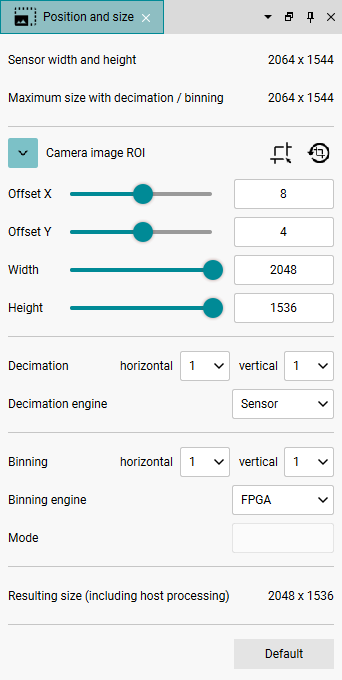
IDS peak 2.17.1 / uEye+ firmware 3.70
IDS Peak comfortSDK, genericSDK, IPL, and AFL developer manuals are external documents. Please contact us if you need them.
You set the image size in the "Position and size" dialog. You can either capture the entire image area or only a detail of the image (ROI: "region of interest"). When you read out an image detail, only that data is transferred to the computer. Depending on the model, this allows you to increase the frame rate. The size of the minimum image detail and the position grid depend on the model and can be found in the respective camera data sheets.
Click ![]() in the tool menu to open the dialog.
in the tool menu to open the dialog.

Fig. 241: Position and size
In the upper part of the dialog you will see the sensor width and height of the camera and below that the different values if you have enabled binning or decimation. At the bottom of the dialog, you see the values if you also apply host processing.
Setting the ROI for the camera image
1.Click on ![]() to open the settings for the ROI.
to open the settings for the ROI.
2.You can set the ROI via the Width and Height sliders and then move the ROI via X/Y offset.
3.Or click on ![]() to draw the ROI directly in the camera window with the mouse.
to draw the ROI directly in the camera window with the mouse.
4.To reset the ROI, click on ![]() .
.
You make the settings for the other ROIs (sub-region) in the respective dialogs:
•You set the ROI for auto brightness in the “Brightness/frame rate” dialog.
•You set the ROI for auto white balance in the "Color" dialog.
•You set the ROI for sharpness measurement in the "Focus/image sharpness" dialog.
•You set the ROI for autofocus (only models with autofocus function) in the "Focus/image sharpness" dialog.
Note that the ROI must be within the camera image ROI (see Sub-regions for auto-algorithms (Exposure, Gain, BalanceWhite, Autofocus)).
Decimation
With decimation (model-dependent), pixels are skipped on the sensor during readout. This reduces the amount of data and may increase the camera speed (depending on the model). The captured image has a smaller resolution, but shows the same field of view as with full resolution.
Depending on the selected decimation engine, different settings are available:
1.Select an engine from the "Decimation engine" drop-down list:
oSensor: Decimation is controlled by the sensor. The availability of this option is model-dependent.
oFPGA: Decimation is controlled in the FPGA ("Region0"). The availability of this option is model-dependent.
oHost (IPL): Decimation is controlled in the host (IDS peak IPL).
2.Use the drop-down lists "Horizontal" and "Vertical" to set the decimation factor.
|
FPGA or sensor decimation is performed directly in the camera, while host decimation takes place only in the post-processing step. Therefore, it is possible to enable host decimation in addition to FPGA/sensor decimation. |
Binning
Binning (model-dependent) averages or sums several pixels on the sensor to a common value:
•If the values are summed up, the image brightness increases.
•If the values are averaged, the noise behavior of the image improves.
This reduces the amount of data and may increase the camera speed (depending on the model). The captured image has a smaller resolution, but shows the same field of view as with full resolution (deviations of the field of view are possible depending on the model).
Depending on the selected binning engine, different settings are available:
3.Select an engine from the "Binning engine" drop-down list:
oSensor: Binning is controlled by the sensor. The availability of this option is model-dependent.
oFPGA: Binning is controlled in the FPGA ("Region0"). The availability of this option is model-dependent.
oHost (IPL): Binning is controlled in the host (IDS peak IPL).
4.Use the drop-down lists "Horizontal" and "Vertical" to set the binning factor.
5.Only with the binning engine "Host (IPL)": Select the binning mode:
oAverage: The values are averaged.
oSum: The values are summed up.
|
FPGA or sensor binning is performed directly in the camera, while host binning takes place only in the post-processing step. Therefore, it is possible to enable host binning in addition to FPGA/sensor binning. |
Image format preset (UI models only)
Use the drop-down list to select a preset for the image size (image profile). You can use these presets to set various common image sizes. The camera driver sets the selected image size using ROI, binning, decimation, or scaler so that it achieves the best possible image quality. The available image sizes are model dependent.
Click on "Load" to apply the selected preset.
